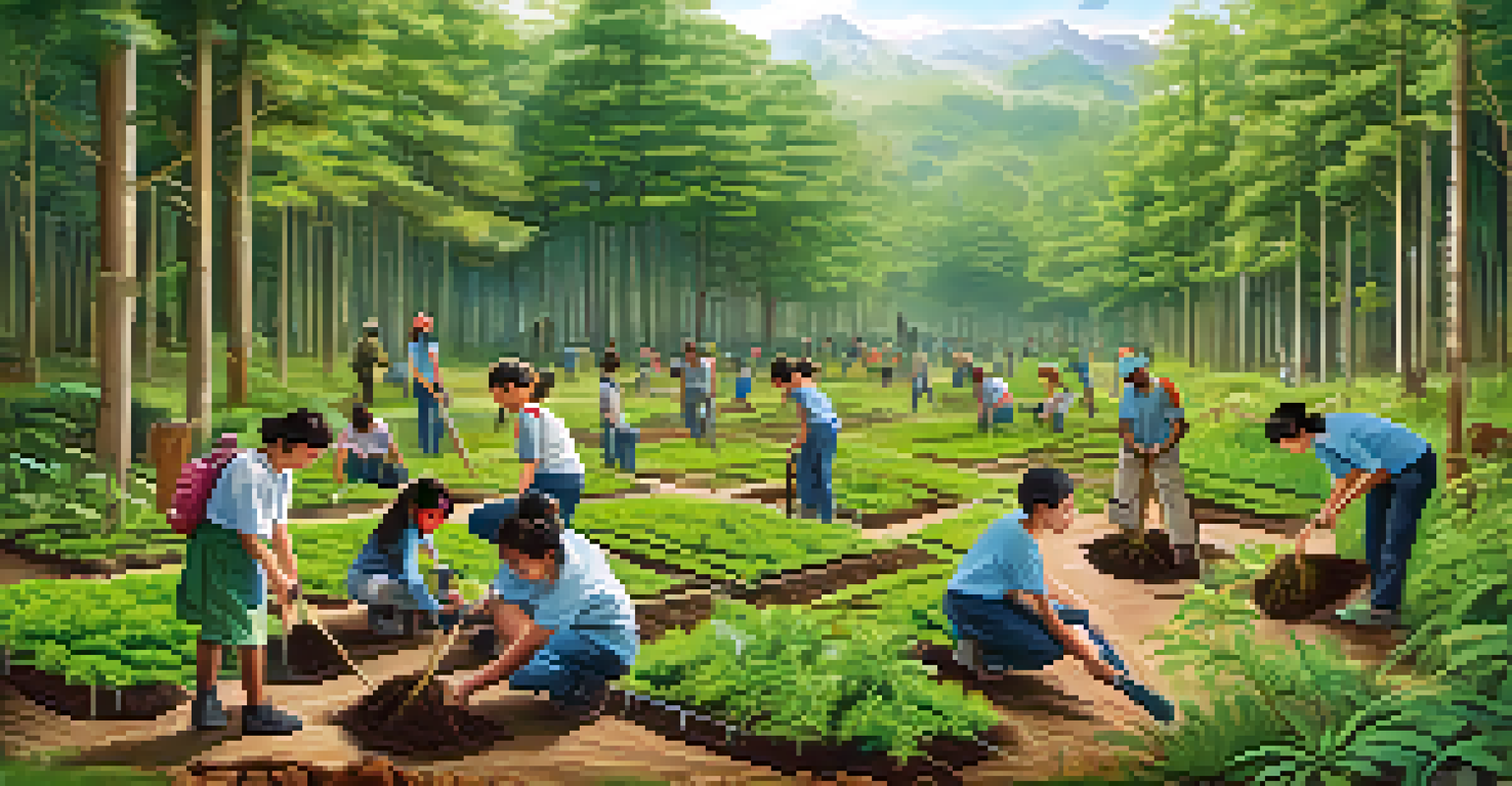Deforestation and Its Role in Shaping Plant Communities' Future

Understanding Deforestation and Its Causes
Deforestation refers to the large-scale removal of trees from forested areas, which can happen for various reasons. Agriculture, urban development, and logging are common contributors to this phenomenon. As forests are cleared, the ecological balance is disrupted, leading to a ripple effect on local plant communities. Understanding these causes is crucial to addressing the broader implications of deforestation.
The clearest way into the Universe is through a forest wilderness.
One of the primary drivers of deforestation is agricultural expansion, where forests are cut down to make room for crops or livestock. This practice not only reduces biodiversity but also alters the natural habitats of countless plant species. Urbanization also plays a significant role, as cities expand and encroach on forested areas for housing and infrastructure. Each cleared area leads to a loss of unique plant communities that may never recover.
Moreover, logging—whether legal or illegal—continues to put immense pressure on remaining forests. This activity often prioritizes certain tree species over others, further skewing the balance of plant communities. As we explore the impacts of deforestation, it's essential to recognize these varied causes and their interconnectedness.
The Immediate Effects of Deforestation on Ecosystems
When trees are removed, the immediate effects on local ecosystems are stark. The removal of vegetation leads to soil erosion, as tree roots that once held the soil in place are no longer present. This erosion can cause sedimentation in nearby water bodies, harming aquatic life and altering entire ecosystems. Without the protective canopy of trees, the microclimate surrounding these areas changes dramatically.

Additionally, deforestation disrupts the symbiotic relationships between plants, animals, and microorganisms. For example, many plant species rely on specific animals for pollination or seed dispersal. When their habitats are destroyed, these relationships are severed, leading to a decline in plant species that cannot reproduce effectively. This disruption can lead to a domino effect, where the loss of one species impacts others.
Deforestation Threatens Ecosystems
The large-scale removal of trees disrupts ecological balance, leading to soil erosion, loss of biodiversity, and altered habitats.
In essence, the immediate aftermath of deforestation is not just a loss of trees but a profound transformation of the entire ecosystem. The cascading effects highlight the intricate web of life that trees support, emphasizing the need for conservation efforts to maintain ecological balance.
Long-Term Consequences for Plant Diversity
As deforestation continues, the long-term consequences for plant diversity become increasingly evident. Forests are home to over 80% of the world's terrestrial biodiversity, and their destruction threatens numerous plant species. Many plants face extinction as their natural habitats are lost, leading to a homogenization of plant communities. This loss of diversity can diminish ecosystem resilience, making it harder for these communities to adapt to changes.
In every walk with nature one receives far more than he seeks.
Moreover, the decline in diverse plant species affects the overall health of ecosystems. Plants play critical roles in carbon sequestration, soil formation, and water regulation. A reduction in plant diversity can disrupt these essential processes, leading to further environmental degradation. For instance, less diverse plant communities may be less efficient at absorbing carbon dioxide, exacerbating climate change.
In summary, the long-term impacts of deforestation extend far beyond the loss of trees; they threaten the intricate tapestry of life that depends on diverse plant communities. Preserving plant diversity is essential for maintaining healthy ecosystems that can adapt and thrive in a changing world.
Climate Change and Its Interaction with Deforestation
Deforestation and climate change are intertwined issues that exacerbate each other. Trees play a vital role in regulating the Earth's climate by absorbing carbon dioxide (CO2) from the atmosphere. When forests are cleared, this stored carbon is released back into the atmosphere, contributing to global warming. The more deforestation occurs, the more difficult it becomes to combat climate change effectively.
Furthermore, climate change can lead to altered rainfall patterns and increased temperatures, which may further impact plant communities. Some species may struggle to survive in these new conditions, leading to shifts in plant distribution and composition. These changes can create feedback loops, where deforestation exacerbates climate change, which in turn leads to more deforestation.
Long-Term Impact on Plant Diversity
Ongoing deforestation endangers numerous plant species and diminishes ecosystem resilience, making adaptation to environmental changes more challenging.
Thus, understanding the relationship between deforestation and climate change is crucial for developing effective strategies to mitigate their combined effects. Protecting forests is not just about preserving trees; it's about safeguarding our planet's climate and the diverse plant communities that depend on it.
The Role of Conservation in Protecting Plant Communities
Conservation efforts play a critical role in protecting plant communities affected by deforestation. Initiatives such as reforestation and afforestation aim to restore areas that have been cleared, helping to bring back lost biodiversity. These efforts not only support the recovery of plant species but also help restore the essential ecosystem services that forests provide, like clean air and water.
Additionally, protected areas, such as national parks and reserves, serve as safe havens for plant communities. By limiting human activities in these regions, conservation efforts help maintain the ecological integrity of these ecosystems. Education and community involvement are also vital components, as local populations can be empowered to participate in conservation efforts and sustainable practices.
In summary, proactive conservation strategies are essential for the preservation of plant communities amidst ongoing deforestation. These efforts not only foster biodiversity but ensure that future generations inherit a healthier planet.
Sustainable Practices to Combat Deforestation
Adopting sustainable practices is key to combating deforestation while still meeting human needs. Sustainable forestry, for instance, emphasizes responsible logging techniques that minimize environmental impact and promote the regeneration of forests. By carefully managing forest resources, we can ensure that we don't deplete them while still benefiting from their resources.
Agricultural practices can also be transformed to reduce deforestation. Techniques like agroforestry, which integrates trees into agricultural landscapes, can enhance biodiversity while providing farmers with additional income sources. By blending agriculture and forestry, we can create more resilient ecosystems and reduce pressure on forests.
Conservation is Key to Recovery
Proactive conservation efforts, such as reforestation and sustainable practices, are essential to protect plant communities and restore ecological integrity.
Overall, embracing sustainable practices offers a pathway to mitigate deforestation's impacts on plant communities. By balancing human needs with environmental stewardship, we can pave the way for a healthier, more sustainable future.
The Importance of Public Awareness and Advocacy
Public awareness and advocacy are crucial in the fight against deforestation and its effects on plant communities. When people understand the importance of forests and the consequences of their loss, they are more likely to support conservation efforts. Educational campaigns can help foster a sense of responsibility towards protecting our natural resources, inspiring individuals to take action.
Moreover, advocacy plays a vital role in influencing policy changes that can lead to more sustainable practices. By raising their voices, communities can push for stronger regulations on logging and land use, ensuring that forests are preserved for future generations. Collaborative efforts between governments, NGOs, and local communities can create powerful movements to combat deforestation.

In conclusion, raising public awareness and advocating for change are essential components in the battle against deforestation. By uniting our efforts, we can work towards a future where plant communities thrive, and forests continue to play their vital role in our ecosystem.